#no evolution just crab
Text


Me and the gang pulling up
#meme#fresh memes#crabcore#crab rave#crabby#time for crab#beach aesthetic#beach babe#beachphotography#beachstyle#original dudes#horseshoe crabs#no evolution just crab#feminine beauty
21 notes
·
View notes
Text
i just love svsss fanfics where Bing-ge meets his own Shen Yuan and just. undergoes bingmeification. he gets hit with the love beams that radiate from Shen Yuan and it’s all over for him. unparalleled.
#kit-thoughts#text post#svsss#like crab evolution#the ultimate form of the Luo Binghe is the Bingmei#i also enjoy fics that acknowledge that it would. in fact. be a difficult process#but the bingmeification speed run fics are just. so fun.#luo bingge#bingyuan#the luo binghe brainrot continues
815 notes
·
View notes
Text

#clauncher#forgot about this thing. is it like. a water/fighting type? or something? hold on#BRUHH pure water okay. i thought it evolved into that one purple punch crab motherfucker that you see all over beaches in sv#simply goes to show that i do not care about either of these pokémon. crabrawler? is that the purple one i was thinking of#yeah it is and THAT THING HAS ITS OWN EVOLUTION okay. ooookay#any little crabby pokémon that looks like this evidently i just do not care about
82 notes
·
View notes
Text
HUGO HUGO OF YOU WE SING
YOURE SO GOOD AT EVERYTHING
#I’ve had this idea saved since this sound was trending XD#this is just Hugo making fun of children and crabs and I love it#for pinto he will also never learn to read he is a child🤨#I dunno either Hugo and the crabs would be besties or not get along there is no in between#I had no clue for the evolution part but I think it makes sort of sense#oujo and rocko look so similar they really copy and pasted didn’t they 🙄#we need a little more of pesos mom too :C#Hugo appreciation weekend🥳#HUGO HUGO#hugo octonauts#octonauts#octonauts a&b#octonauts above and beyond#above and beyond#peso octonauts#this is a Pinto hate post in disguise /j >:)#this is rly stupid but it’s my greatest achievement ever
21 notes
·
View notes
Text
I miss forums but specifically, I miss how forums have specific areas for things. like if you weren't done reading a series yet but you wanted to talk about it, chances were there was a spoiler-free section specifically for the first book. if you just wanted to chat with people about whatever, there was an off-topic section. if you wanted to discourse about vriska, you went to the vriska quarantine threads. now I take one step into a fandom tag and am barraged on all sides by 20 different tangentially-related conversations and arguments that I care nothing about
#I know reddit is still separated by topic but I've also been seeing a shift in reddit#where a lot of subs are becoming more like. homogenous with each other?#I've complained about /r/namenerds before but it used to be a sub to discuss baby name trends and interesting names across the world#but all the time now people post things about how their sister-in-law used the same baby name as them and it's like#okay sure. I GUESS that's barely related to names. but it's not what this sub is supposed to be#every sub on reddit feels like it's slowly slowly morphing into AITA for some reason. like crab evolution#personal ramblings#idk where I'm going with this I've just been lurking the godot forums for gamedev and got nostalgic for the mspa & wc forums
1 note
·
View note
Text
Doylist explanation: They keep making new electric mouse pokemon because they're frantically trying to recreate the success of Pikachu. Or at least because it's tradition at this point.
Watsonian explanation: A major predator of rodents is birds of prey. A mouse that can deliver electric shocks to flying-types has a much higher chance of living to produce more offspring. Thus, convergent evolution fills this niche in every region. "Pikachu" is just the pokemon universe equivalent of "crab".
41K notes
·
View notes
Text
Simple lifeform facts I take for granted that I've now seen blowing people's minds on here:
That sea urchins walk around and have mouths with teeth on their undersides
That corals are related to jellyfish
Barnacles being related to crabs and shrimp
Ants being an offshoot of wasps
Termites being totally unrelated to ants and all similarities just being convergent evolution (they're actually a group of cockroaches, but even science didn't know that part until a few years ago)
Starfish having an eye at the end of each arm
That the bodies of ticks and mites are also their heads, essentially big heads with legs (they even frequently have eyes way up on "the body")
Sperm whales have no upper teeth, and also their bodies are flat from the front
Goats also having no upper (front) teeth
Tapeworms having no mouth at all and just absorbing nutrients over their entire body surface
That flies are bigger pollinators than bees
That moths are bigger pollinators than bees
That wasps are just as important pollinators as bees (more important to many groups of plants) and when we say they're "less efficient" at it we just mean individually they get a little less pollen stuck to them.
That honeybees are nonnative to most of the world and not good for the local ecosystem, just good for human agriculture
That earthworms are also nonnative and destructive to more habitats than the reverse
There being no hard biological line between slugs and snails; all slugs aren't necessarily related to each other and there are gastropod groups where some have shells and some don't
That ALL octopuses (not just the blue ring) have a venomous bite
Most jellyfish and sea anemones being predators that eat fish
"Krill" being shrimp up to a few inches long and not some kind of microbe
Blue whales therefore being the deadliest predators to ever evolve as they eat up to several million individual animals per day
That krill are still "plankton" because plankton refers to whatever animals, algae and other organisms are carried around by the sea's currents, not to any particular group of life or a size category
Fungi being no more related to plants than we are, and in fact more like a sibling to the animal kingdom if anything
Venus fly traps being native to only one small area of North America in all the world
Parasites being essential to all ecosystems
Leeches not having a circular ring of teeth anywhere
That algae is not a type of plant
That most seaweed is just very big algae
That enough wood ends up in the ocean that plenty of sea life evolved to eat only wood
Speaking of which the fact that the "ship worms" that make tunnels in wood are just long noodly clams
Butterflies technically just being a small weird group of moths we gave a different name to
That insects only get wings once they reach maximum size and therefore there can never be a younger smaller bee or fly that's not a larva
Spiders not being any more likely to kill their own mates/young than just a cat or dog might, for most species maybe a lot less often?
6K notes
·
View notes
Text
Who designed the gen 9 Pokémon why are they all ugly
#i think i only have one gym left?#and one team star guy maybe#and i havent seen a single new mon i like ????#the dogs are ok ig#but like they arent good#that poison monkey is probably my favourite so far but#why is the pre evolution like a weird blob#when i first saw it i thought it would evolve into the non legendary motorcycle#actually thats smth ive noticed with this gen a lot of the evolutions dont look like they belong together#like theat little floating thing evolves into the ugliest bird of all time?#also what the fuck is that ice ball Pokémon with the weird mouth#it says landwhale Pokémon tf is that supposed to be#wait i just remembered the crab thats probably my fav one from this gen#omg the chili pokemon gotta be the ugliest thing ive ever seen in my life#like all these mons are gen 5 lvl unappealing#but at least gen 5 had a few good ones you know#oh ig the flamingo is good?#i havent seen the water starter yet so i still have some hope that one looks good at least#i picked the fire one cause i always like croc pkmn#but it was a mistake he turned into a weird clown wig guy#with awful colouring#and a very annoying cry#and the cats final form is fkn ugly#like at least the fire croc is very different (worse) than feraligatr#but the plant cat is literally the same as the fire cat#just a bipedal dude again wtf
1 note
·
View note
Text
Fun New Treasure Table. Roll A D10!
Normal boring treasure. What a disappointment.
Just a big vat of EXP. Grab a straw, lads!
Hot indie video games, but it's the D&D world so no-one can play them.
Colony of mimics playing the long con. They act like gold until you pay for something with them, then they eat the shopkeeper. Play along and they'll share the tastier organs ;)
Crabs. The Dragon heard that they're the end point of evolution so collected them all to become the ultimate lifeform.
Holy texts all written about the GM, which the GM reads to you in excruciating detail.
All the rejected Deck Of Many Thing cards that were thrown out for being too game-breaking.
Blades In The Dark characters who are in this system as part of their latest heist. Make a fortune roll!
Massive amounts of exotic physics matter. If you take it out, it'll start a chain reaction that will destroy the world. Also, in a neat physics discovery, it looks exactly like precious stones.
Me. Please let me out. It's been years.
635 notes
·
View notes
Text

#just randomly got this news thingy recommneded to me#ok then#evolution 🧬 only ‼️ cares 🤩 about 💕ONE 1️⃣ THING 👈 and its🤗 CRABS 🦀#||#fall speaks#crabs
0 notes
Text
weird fucking animals in the sea tier list
big fin squid. what in the actual fuck is this?
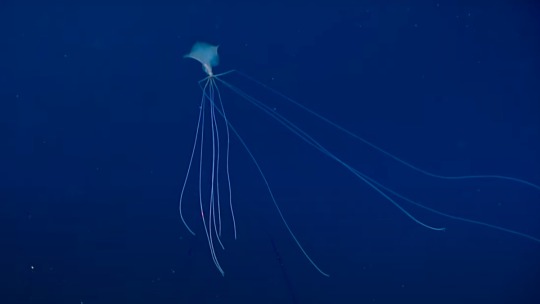
2. phronima. inspired the face hugger from alien
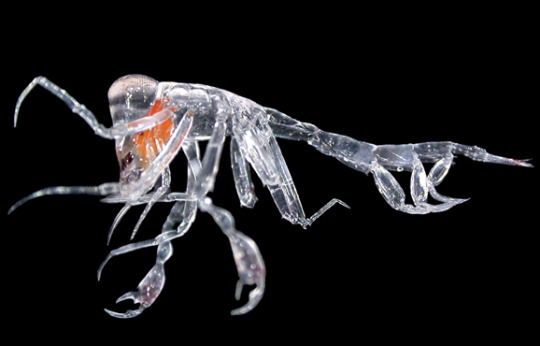
3. big red jellyfish (thats its scientific name....)
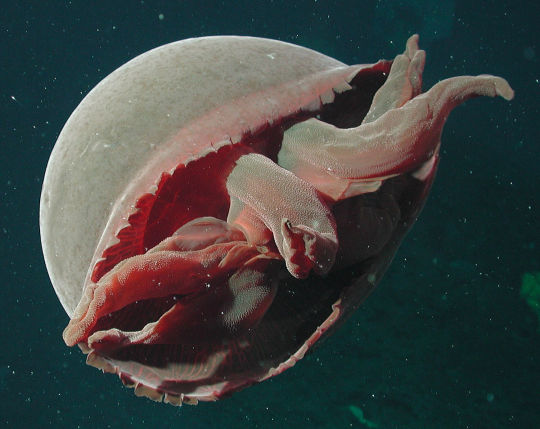
4. squid worm???????? wtf is this monstrosity against god? (i love it)
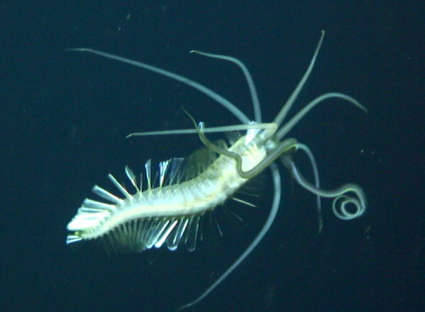
5. frilled shark....just why?
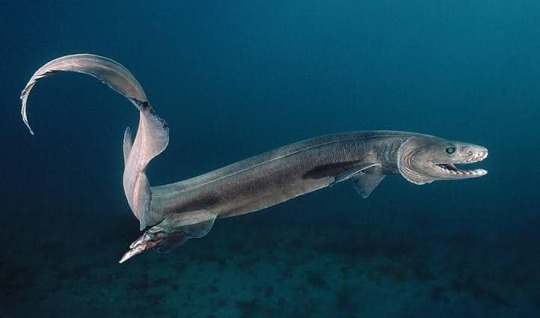
6. barrel eye fish. its cute i guess but it looks so sad like a renaissance painting:( hey little guy cheer up you have lots of fans x
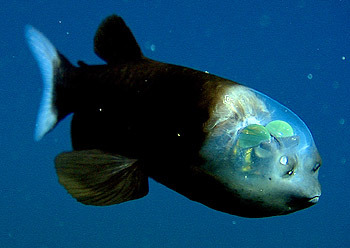
7. chained cat shark so cool but why tf is it in our ocean
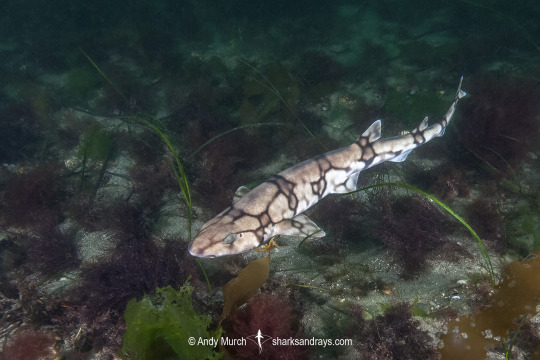
8. japanese spider crab (i love this freaking thing but even a fan like me has got to admit this looks like a dark souls boss you'll die to 500 times before looking up various elemental tactics on reddit and gamefaqs.
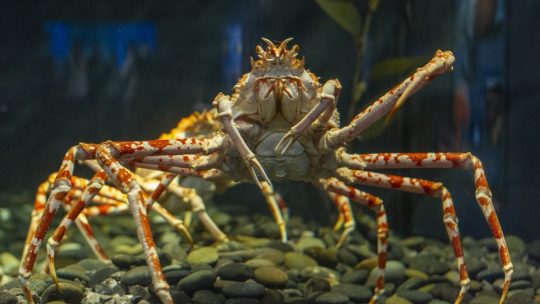
9. bristle worms. they are sturdy to me ♥

10. blobfish...shes not that weird to me the thing thats weird is that people apperently eat it??? but folks will eat anything i swear to god. leave it alone its just a weird guy!!!!!!!
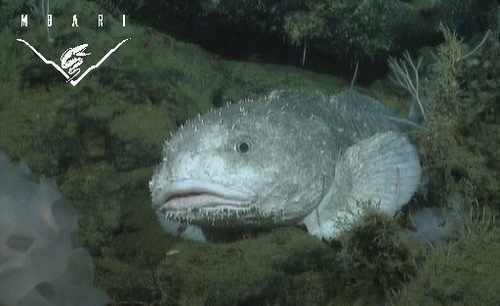
11. goblin shark. presented with no further explination. shark evolution is so fucked man

12. sixgill shark. he's back and hes coming in hot. i love his goofy ass
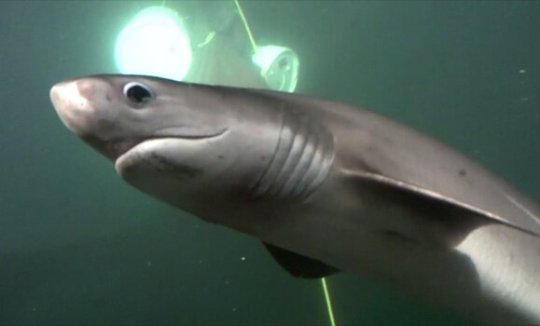
13. whatever in gods green earths name this is (black swallower, shes soooo real)

14. is it a tier ranking without me bringing up 12 squids? i dont think so. this here's a vampire squid, miss, a fine specimen for sure
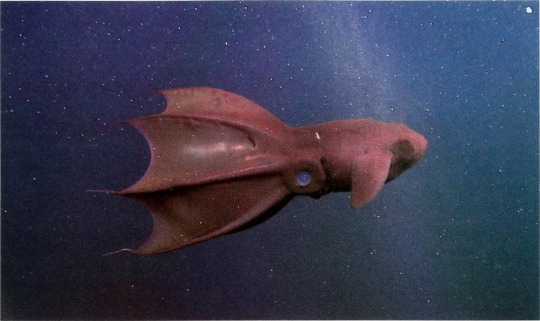
15. gulper eel. ???

#thalassophobia#marine biology#most of these summarised: i hate it. its so cool i love it#now coming hot with 15 different weird guys to enjoy#i want to honor my roots and thank my followers from marine biology tumblr with a huge deal#you all probably know already about these<3 recommend me more weird guys for us to enjoy please#i should mention this post is sponsored by vegan propaganda#do NOT eat these. let them exist i love to see it<3
538 notes
·
View notes
Text
Other posts go into more detail on this, but if you ever find a meme-like claim that a certain taxon has "never evolved" since so and so millions of years, it's most likely that, just a meme.
Crocodiles? Land crocodiles were, at many points of history, as common as amphibious crocodiles. In South America when it was a island-continent, they were among the main predators.

Horseshoe crabs? They have a rather well documented evolutionary history.
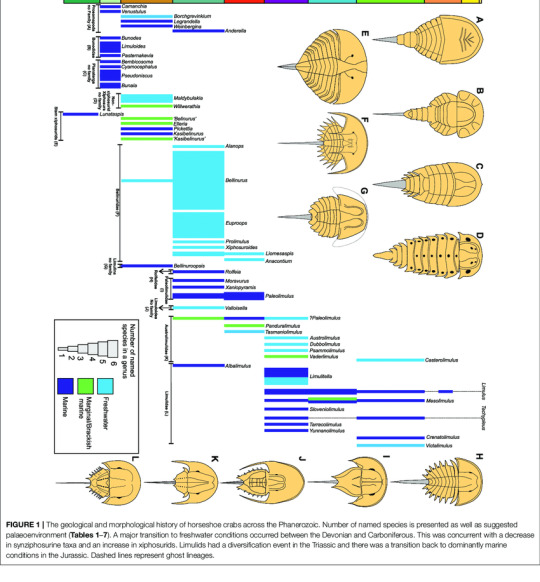
Sharks? Buddy you aren't even ready to know how fucking weird prehistoric sharks were:
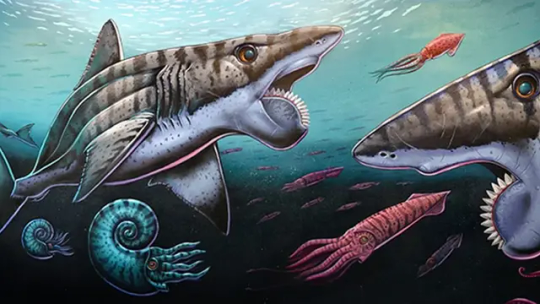


(in order: Helicoprion (ONE reconstruction, we still don't have any idea how it worked), Stethacanthus, Aquilolamna)
Yes, for sure, some life forms have been very successful, I won't pretend the amphibious crocodile body plan hasn't been very succesful and conservative since the mesozoic. Plants are also remarkably conservative (not as much as you'd think, though). But every time you see the "X hasn't changed at all for millions of years, it's the perfect creature!" it's just a meme that obscures real life evolution and diversity.
#like that annoying meme that says chickens are the most related to T-rex (no they aren't)#cosas mias#evolution#biology#paleontology#this is mostly an excuse to show you weird sharks I love sharks
94 notes
·
View notes
Note

Gently hands you these so w can watch together.
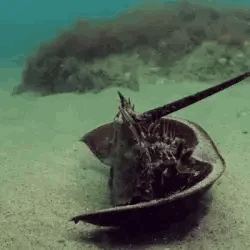
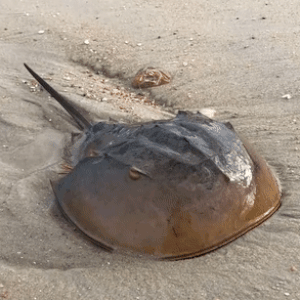
HORSESHOE CRAB BOIS!
I love these guys. It's so crazy you can just walk out on a random beach and see a bunch of heckin' 480 million year old living fossil dudes just sitting there, minding their own business. It's bonkers. Physiological evolution is for chumps. (also they unlocked a rare unique blood perk so that's cool).
It's also a case of the English word for something being very underwhelming. 'Horseshoe crab', really? This thing that doesn't even look like a crab and is one of the very few things left on this earth that is not (yet) carcinized? That only in the most abstract way possible actually resembles a horseshoe? All the alternate names for them are also just "thing crab".
I dunno, they're just so weird and unique that it just seems wrong to name them after other things. I would like to call them Blomblers™ instead.
#science#biology#evolution#marine biology#horseshoe crab#blomblers#i mean it would literally be more accurate to call them “horseshoe trilobites”#asks
167 notes
·
View notes
Text

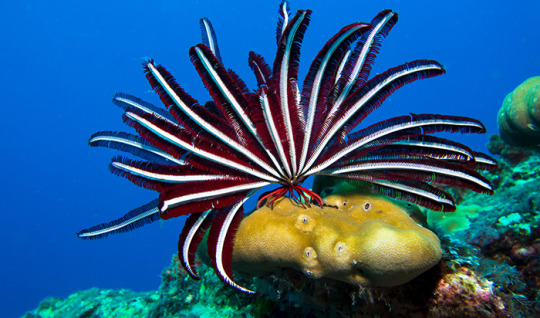
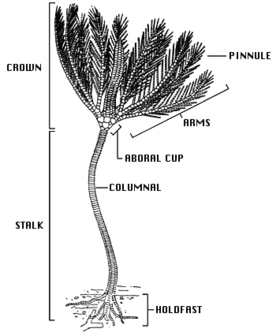
Star feathers are unique, they have high resemblance to pre-historic aquatic fauna; plants. Just like horseshoe crabs, their existence as a subset of species dates back to millenniums.
These are mobile versions of crinoids, that's a member of animalia (animal organisms), their original predecessors that came first --- the prehistoric plant-versions of crinoids that were rooted in the sea's sand as shown in the bottom figure were also animalia, but have differences in mobility. The rooted plant crinoids are among the oldest prehistoric members of lifeforms that dates back to even before the Cambrian explosion period.
Fossils of crinoids are often seen in fossil marketplaces, alongside fake's, but these more recent versions of crinoids which have genetically adapted through evolution to thrive and live outside of the sand and actually swim amongst other fish, it was a characteristic often seen in the ocean's habitat.
────────────────────────────────────────────
⇾ Follow my page for more epic, silly and boomblu content; share so I can grow if you wish, and come visit my other socials at my Linktree [Just click the word Linktree, it's hyperlinked :)]. ⇽
Check out the rest of my posts too!!! A lot of them are underrated. ;o Like everything you find interesting if you want. :3
Remember, you can find all of my socials here (click the word [here], it's hyperlinked (。◕‿‿◕。) For the plain link; here it is: https://lynkfire.com/Gliphel&Glyph%20LLC%20Incorperated
Also; if you prefer Linktree, it's here.
#aquatic#aquatic life#fish#fishposting#fishblr#marine#sea creatures#sea#ocean#water#ocean life#oceancore#underwater#feather star#crinoid#prehistoric#paleontology#marine life#cute animals#sea animals#dinosaur#animal#animals#organism
305 notes
·
View notes
Text
Every day I want to grab people and shake them and tell them to shut the fuck up about carcinization. Every day I want to tell them that crustaceans evolving into similar body types isn't that impressive and that it's just adaptation to their ecological niche. The way we define crab is so loose and these are species that are already relatively closely related anyway. Convergent evolution is a broad phenomenon and it happens all the time and there are way weirder examples than a thing that was already nearly a crab becoming a crab.
There's a horse that's a gorilla.


This is a real animal that existed and lived and walked around in a semi upright posture and it's related to modern horses.
Fish, reptiles and mammals all keep turning into sharks.


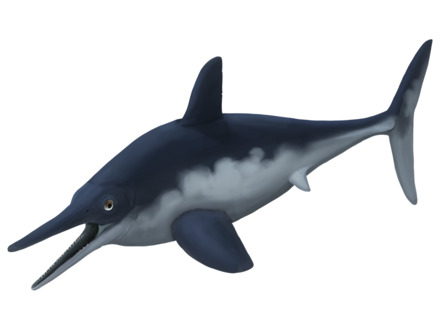
These animals couldn't be much more distantly related while still having a spine. Shut the FUCK UP about carcinization.
Anyway that's what I would say if I was on a website where people weren't all slightly obsessed with crabs.
#crabs#carcinization#convergent evolution#biology#evolution#nature#shark#dolphin#dolphins#ichthyosaur
287 notes
·
View notes
Text
Happy New Year!
Let's imagine it was the Earth itself that was going into its 2024th year. That is to say, we're compressing the entire history of the Earth into just the past 2023 years. What events would have happened when?
Well, not too much is certain about the first couple decades after our planet formed, until around 50 CE when we were hit by another proto-planet, Theia, and the debris formed the Moon. After a couple years of the planet cooling down again, the oceans formed out of boiling rain. The timing of the origin of life is very uncertain, but there are chemical signs it may very well have happened as early as the second century. Around 200 CE, the gas giants did a big funky orbit-swapping dance, and in the process inflicted the Late Heavy Bombardment on the rest of the solar system, meaning the Earth was suffering a ton of meteorite strikes for the entire third century.
The first indisputable evidence of life is from around 330, and the first stromatolites appear around 470. Those are basically the first fossils, stones created by layer upon layer of oxygen-producing cyanobacteria living and dying on top of one another. But even with oxygen producers evolving, it would take many centuries before oxygen became a major part of the atmosphere: not until the Great Oxygenation Event, which happened during the ninth and tenth centuries. That's also about the time the first complex, eukaryotic cells evolved through a symbiosis between an anaerobic archaean and an oxygen-breathing bacterium. The bacterium became more and more focused on just the oxygen-breathing task inside the larger cell, until its descendants were mitochondria, which as you all know are the powerhouse of the cell. The next seven centuries passed by with only slow, gradual changes, and life continuing to be unicellular and difficult to find in the fossil record.

(1735's Snowball Earth, by me)
From 1704 to 1730, the entire planet froze over. After merely two years of thaw, it happened again, this time lasting from 1732 to 1742. But these snowball Earth episodes set the stage for the evolution of animals that began right after. Across the mid-18th century, the bizarre Ediacaran biota, with its strange symmetries, fronds, and fractal-like pattern filled the oceans. In the early 1780s they went extinct, possibly due to a temporary drop in oxygen-levels, only to be replaced by a great variety of quite different creatures in the Cambrian Explosion.
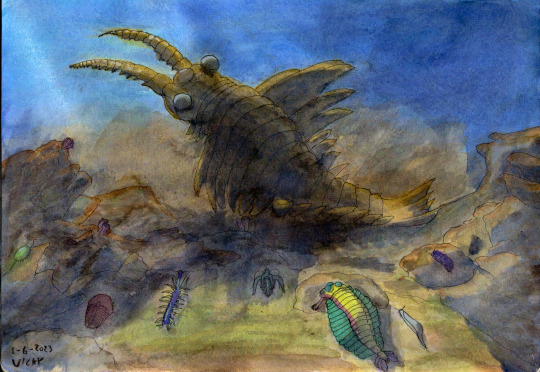
(Class of 1799, by me)
Starting in 1784 and running for a few decades, the Cambrian period saw the origin of most of the modern animal phyla, reaching its most famous form in the Burgess Shale fauna of 1799. During this time, most animals still lived on the sea floor, either attached or crawling, with relatively few actually swimming creatures. Plants started tentatively moving onto land around 1817, and in 1825, the rising of the great Appalachian mountains caused a severe drop in global CO2 and thus temperatures, leading to the Late Ordovician mass extinction.

(Horseshoe crabs and sea scorpions on a beach in 1834, by me)
Bony fish first showed up during the 1830s, and around the same time plants were getting serious about inhabiting the land, evolving roots and vascular tissues so they could properly grow there. Millipedes and the ancestors of spiders were the first animals to follow them onto land. Our own fishy ancestors did not take their first step until 1857, by which point the arthropods were well established there and the plants had figured out how to become trees. The Late Devonian extinction, partially caused by the evolution of said trees and partially by the south pole freezing, played out in two pulses over the late 1850s and early 1860s.
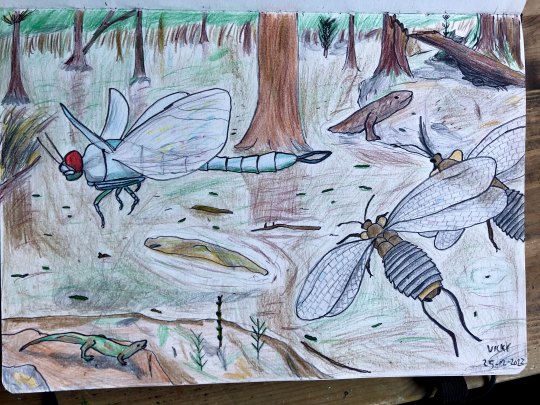
(Swamp prominently featuring Meganeura and Mazothairos in 1889, by me)
Arthropods and vertebrates continued to gain adaptations to life on land. The insects became the first creatures ever to fly in 1878, and the high-oxygen atmosphere of the time would be especially good to them. Around 1884, a group of vertebrates called the amniotes, after the membrane that kept water inside their eggs so they could lay them on land without them drying out, split into two groups: the reptiles and the synapsids (which we mammals descend from). The next few decades would see the synapsids in particular being extremely successful as the supercontinent Pangaea formed. Until 1912, when a massive episode of volcanism caused the worst mass extinction of all time, the Great Dying, scouring the Earth of a huge portion of its life.
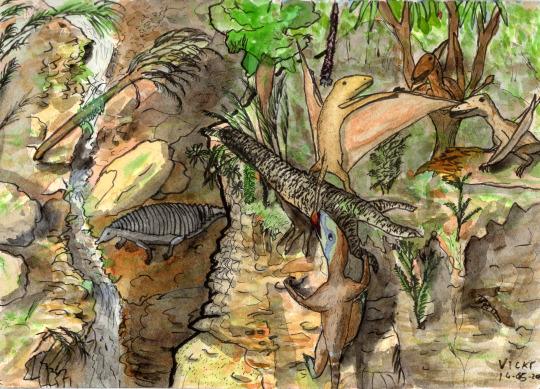
(A 1930 scene featuring the three branches of archosaur: dinosaur, pterosaur, and pseudosuchian, by me)
The 1910s were a period of slow recovery during which strange new forms of animal evolved. Many different, unrelated reptiles, such as the ichtyosaurs and plesiosaurs, went to sea, where they would continue to provide some of the most impressive creatures for most of the 20th century. On land, the dinosaurs first appeared in 1920, though for the next decade or so they'd live in the shadow of their pseudosuchian (crocodile-line) cousins. In 1934, Pangaea began to break up, resulting in another terrible pulse of volcanism that caused a lot of extinctions and left particularly the feathered and furry survivors with a lot of empty niches to fill, allowing the dinosaurs and mammals to diversify greatly. The last common ancestor of all modern mammals lived in the early 1940s, and by 1957 the dinosaurs had figured out flight, with Archaeopteryx usually being considered the first bird. Other dinosaurs took on an incredible variety of sizes, shapes, and forms. Some of the most famous ones include Dilophosaurus (1942), Diplodocus and Stegosaurus (1955), Iguanodon (1969), Velociraptor (1991), and Tyrannosaurus rex (1994).

(A tropical lakeside in the year 2000, by me)
In 1995, the world was struck by a meteorite, wiping out many groups, including the marine reptiles, pterosaurs, and ammonites. The surviving mammals and dinosaurs went on to diversify across the next couple of years and had formed thriving new ecosystems in the tropical world of the turn of the millennium. The first known bat lived in 2001, and the whales returned to the oceans next year. Around 2009, the world's climates turned colder and dryer. Antarctica froze over and grasslands spread widely. Our last common ancestor with the chimpanzees and bonobos lived in 2021, and by new year 2023, our ancestors were getting brainier and more proficient with tools. That's also when the north pole froze and the Quaternary ice age cycle began. The first known members of Homo sapiens lived on 10 November 2023. The latest ice age started on 14 December, and ended at 2 AM on 30 December. The great pyramid of Giza was built at 6 AM on 31 December and On The Origin Of Species was published at 23:22 PM.
#palaeoblr#happy new year#2024#geologic timescale#vicky's vritings#one year is 2.244 million years if you're curious#and yes i did exclude both year 0 and 2024#since 0 doesn't exist and 2024 hasn't happened yet#my art#i rather enjoy having an extensive collection of my art to illustrate my paleorambles nowadays#incidentally the big bang occurred in 4121 bce at this scale#which is curiously close to the date of creation creationists made up#if only they would follow through and insist humanity itself was seven weeks old too
124 notes
·
View notes